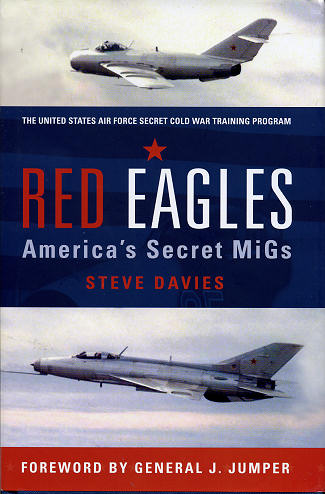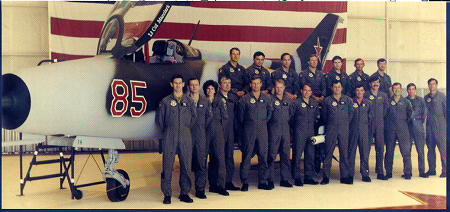 Every
once in a while, one runs across a book that simply sucks one into the story
from page one until the end of the book. This is one of those.
Every
once in a while, one runs across a book that simply sucks one into the story
from page one until the end of the book. This is one of those.|
Author: |
Steve Davies |
|
Publisher/Distributor |
Osprey Publishing |
|
Price |
$25.95 MSRP |
|
Reviewer: |
|
| Notes: | 352 pages, hardbound, ISBN: 1-84603-378-0 |
 Every
once in a while, one runs across a book that simply sucks one into the story
from page one until the end of the book. This is one of those.
Every
once in a while, one runs across a book that simply sucks one into the story
from page one until the end of the book. This is one of those.
Author Steve Davies tells the story of the USAF's secret training program using Soviet MiGs from a secret base at Tonapah, Nevada. These MiGs initially came from testing at Groom Lake (Area 51 if you will) in the mid 1960s. Those of you who are familiar with the MiG-17s and MiG-21 provided to Israel by defecting pilots, will soon realize that these planes provided the kernel of an idea that it would be good to provide some sort of combat training for American pilots against the real thing. Prior to this, there was only air combat training using like aircraft types. The experiences in Vietnam showed that this wasn't working well so Top Gun and the USAF's aggressor squadrons started providing dissimilar training using F-5s, T-38s and A-4s. But these were not MiGs. Just about all pilots got 'buck fever' when first encountering MiGs in combat. It was enough to provide the enemy with an advantage that would get the affected US pilot in a heap of trouble. Since the US had MiGs, why not use them for that initial contact where it was relatively safe. Nothing flies like a MiG than a MiG.
The initial MiGs were not enough so a deal was made with Indonesia for their now abandon MiG-21 F-13s. These were often little more than hulks and the men chosen to maintain the planes often had to do the sort of rebuilds that are done for warbirds. The work they did was phenomenal. Teams were sent around the world to scrounge parts, but to do it clandestinely. Engines were another problem. The Soviets built their engines to last 100-150 hours and then be scrapped. They did not do reworks. Contracting with G.E., the unit was able to get a somewhat reliable source of engines.
All this was done in strict secrecy. The pilots and ground crew were not allowed to tell their wives or families what they were doing. If someone died in one of the jets, the wife would not find out the actual cause until decades later. Code names were given to the aircraft like YF-112, YF-113 and so on. Pilots were pulled from the best there was and by the end of the program in 1989 (it was terminated along with all the overseas aggressor units as a cost savings measure), 69 pilots from all services had been Red Eagles and hundreds had been exposed to training with them.
This is, for the first time, the full story of the Red Eagles. A saga that takes them from a few planes to flying a number of MiG-17s, MiG-21s of different variants, and the MiG-23, a plane that is wickedly quick, but very dangerous for even experienced pilots to fly and the cause of several accidents and fatalities. The MiG-21 was considered by all to be a real delight to fly and one that generally trounced anything other than an F-15 or F-16 in a turning battle.
 But
it is mostly the story of the men who flew and maintained these aircraft that is
the best part of the book. Their trials and tribuilations with the brass hats is
enough to anger most who read about some of the problems they faced keeping
their unit going. The addition of the F-117 wing to their base also added to the
problems facing the Red Eagles. Even now, many will not talk about their time
with the unit and those that will set strict limits on what can and cannot be
said, so the full story has really yet to be told.
But
it is mostly the story of the men who flew and maintained these aircraft that is
the best part of the book. Their trials and tribuilations with the brass hats is
enough to anger most who read about some of the problems they faced keeping
their unit going. The addition of the F-117 wing to their base also added to the
problems facing the Red Eagles. Even now, many will not talk about their time
with the unit and those that will set strict limits on what can and cannot be
said, so the full story has really yet to be told.
In addition to the excellent write-up, there are a number of photos that have never before been in print. While some planes have been destroyed (the Egyptian and Chinese MiGs for instance), many of the early MiG-21F-13s suddenly appeared in museums so if you see one, it was most likely part of the equipment of the Red Eagles.
So good is this book that if you buy only two or three aviation books a year, this one needs to be one of those.
October 2008
For more on the complete line of Osprey books, visit www.ospreypublishing.com or contact them at Osprey Direct, PO Box 140, Wellingborough, Northants, NN8 2FA, UK. In the US, it is Osprey Direct at 44-02 23rd St, Suite 219, Long Island City, NY 11101., where you can get a catalogue of available books.
If you would like your product reviewed fairly and quickly, please contact me or see other details in the Note to Contributors.